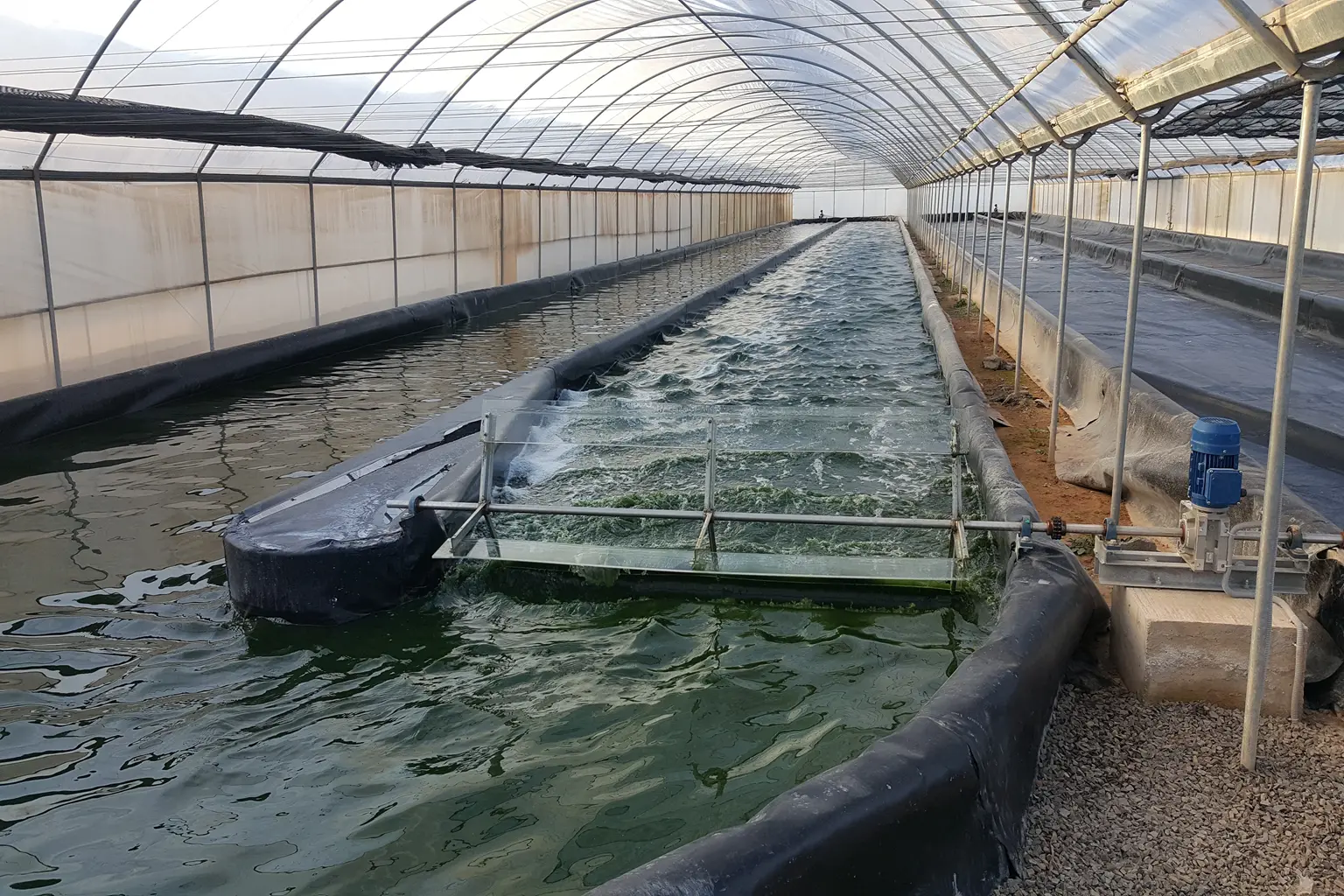Raceway ponds are the heart of large-scale spirulina farming. These paddlewheel-driven, shallow, looped water systems offer the perfect environment for cultivating spirulina algae under controlled, organic – compliant conditions. From their elliptical shape to their automated flow patterns, raceway ponds are designed to balance sunlight exposure, aeration, and nutrient distribution – everything spirulina needs to thrive.
In this guide, we’ll break down the raceway pond system and explain why it’s the gold standard for commercial spirulina cultivation in India and around the world.
What is a Raceway Pond?
A raceway pond is an engineered open pond system, typically built with a cement base or HDPE-lined earth structure. It’s designed in a looped channel (like a racetrack), usually with rounded corners and a divider in the center. A paddlewheel circulates the water, ensuring continuous movement and preventing stagnation.
Key Features:
- Shallow depth: Usually 20–30 cm to optimize light penetration
- Length: 10–150 meters depending on scale
- Paddlewheel speed: 10–25 RPM to maintain flow
- Divider wall: Separates inlet and outlet channels
- Aeration-friendly: Promotes oxygen exchange
- Compatible with SS filters and mesh covers
Raceways can be modular and expanded in stages, making them suitable for phased growth models. This flexibility is crucial when planning multi-acre projects with future expansion in mind.
Why Spirulina Thrives in Raceway Systems
Spirulina is a photosynthetic, filamentous cyanobacteria. For optimal growth, it needs:
- Consistent temperature (30–35°C)
- Alkaline pH (9.5–10.5)
- High light exposure
- Uniform nutrient availability
- Minimal contamination
Raceway ponds naturally fulfill these conditions. The shallow, constantly circulating water allows uniform light and temperature distribution while minimizing sedimentation and bacterial zones.
Biological Advantages:
- High surface-area-to-volume ratio
- Encourages robust spirulina morphology
- Prevents dead zones or filament clumping
- Supports higher biomass per square meter
- Easily monitored and sampled
In contrast to enclosed photobioreactors, raceways allow for easier intervention, quicker visual assessment, and more cost-effective troubleshooting.
Cost-Efficiency at Scale
Raceway ponds are cost-effective for farms from 3 to 10+ acres. Unlike photobioreactors or vertical tanks, raceways are simple to construct and maintain.
Capital Efficiency:
- Uses solar energy for light – no artificial lighting needed
- Easy to automate with IoT sensors and SCADA
- Low-cost agitator/paddlewheel operation
- Fewer moving parts = lower maintenance
Their operational expenditure is also lower than other systems due to minimal energy input and easier cleaning processes. This makes them ideal for farms in sunny, tropical climates where solar access is abundant.
For details on scaling raceways into full commercial infrastructure, visit our full spirulina farming setup guide.
Organic & GMP Compliance
Raceway ponds are easily adapted to USDA Organic and GMP guidelines, making them a strong foundation for certified spirulina export compliance:
- Built with food-grade materials (SS 316 or HDPE liners)
- Easy to sanitize using approved agents
- Compatible with OMRI-listed feed systems
- Mesh-covered to prevent pest contamination
- Allows traceable batch-wise culture management
They also offer better control over contamination risks when combined with SOPs and water treatment protocols. Culture health logs can be linked to each raceway, enhancing transparency during audits.
These systems form the foundation of most turnkey spirulina farms designed for export and premium markets.
Design Tips for Optimal Performance
- Use a cement base with rounded corners for longevity and easy cleaning
- Maintain depth between 20–25 cm for maximum light exposure
- Angle paddlewheel blades to promote laminar flow
- Include overflow guards and sludge traps at each turn
- Divide ponds into zones for staged harvesting or rejuvenation
Adding water level indicators, flow meters, and automatic feed dosing improves consistency and prevents operator error.
Raceway Construction Materials and Layout
Common Materials:
- Cement + Waterproof Paint – Long-lasting but higher capex
- HDPE Film with Earthen Walls – Cost-effective but needs expert lining
- Fiber-Reinforced Plastic (FRP) – For portable/demo units
Layout Planning:
- Buffer space between ponds to prevent cross-contamination
- Drainage slope for easy sludge removal
- Space for lab, harvest, and drying units nearby
Integrated with Harvesting & Drying Systems
Raceways connect directly to harvesting tanks and low-heat dryers. For an end-to-end overview, see our guide to the full spirulina farming process. Farms can install RWD (Refractive Window Dryer) or vacuum dryers beside raceway zones, minimizing transfer time and preserving culture purity.
Proper integration improves traceability, minimizes contamination, and supports batch-level COA generation.
Learn how this integration works in our automation and SCADA guide.
Monitoring Culture Health in Raceway Systems
Monitoring is essential to detect early signs of stress:
- Daily pH, temperature, and OD (Optical Density)
- Microscopy every 3–5 days to check filament integrity
- Routine visual inspections for color, bubble pattern, and texture
Advanced farms integrate sensors that provide real-time alerts when thresholds are crossed. These systems are particularly helpful in monsoon or extreme summer periods.
Raceways vs Other Cultivation Methods
| Cultivation Method | Cost | Nutrient Retention | Organic-Ready | Scalability | Maintenance |
| Raceway Ponds | Low-Medium | High | ✓ | High | Moderate |
| Photobioreactors (PBRs) | High | Medium | ✕ | Low | Complex |
| Vertical Tank Systems | High | Low | ✕ | Medium | High |
Cleaning & Maintenance SOPs
Raceway ponds need scheduled cleaning to remain efficient and contamination-free.
- Weekly paddlewheel shaft lubrication
- Biweekly brushing of pond walls
- Monthly drain and full cleaning during off-season
- Use of food-safe sanitizers and water flush after cleaning
All cleaning should be logged with timestamp and staff name for traceability.
Conclusion: The Gold Standard for Spirulina Cultivation
Raceway ponds remain the most scalable, cost-effective, and organic-friendly system for growing spirulina in tropical and subtropical regions. With proper SOPs, automation, and batch logging, raceways deliver consistent quality that meets both local FSSAI and global USDA/EU Organic standards.
Ready to build your own raceway system? Explore our turnkey spirulina farming packages or connect with our design experts today.



